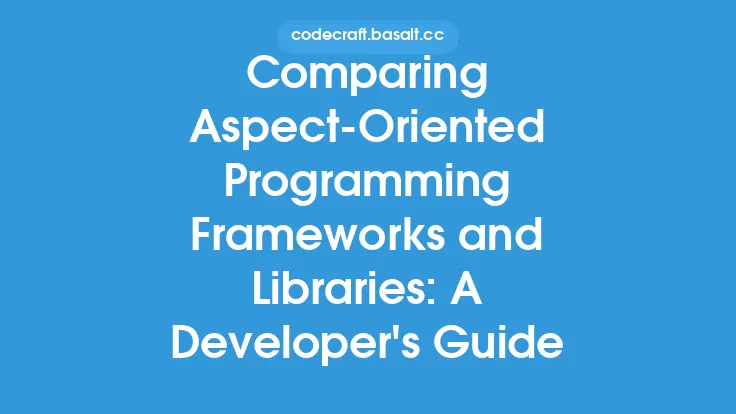When it comes to writing clean and maintainable code, developers often face the challenge of addressing cross-cutting concerns that span multiple modules or objects. Aspect-oriented programming (AOP) provides a solution to this problem by allowing developers to modularize these concerns and weave them into the main codebase. In this article, we will delve into the implementation of aspects, exploring the concepts, techniques, and best practices for writing clean and maintainable code using AOP.
Introduction to Aspects
Aspects are the core components of AOP, representing a modular unit of code that encapsulates a specific concern or functionality. An aspect typically consists of a set of advices, which are executable pieces of code that implement the concern, and a pointcut, which defines the locations in the code where the advice should be applied. Aspects can be thought of as a way to decorate or augment the existing code with additional functionality, without modifying the original code.
Types of Aspects
There are several types of aspects, each serving a specific purpose. The most common types of aspects include:
- Interception aspects: These aspects intercept and modify the behavior of existing code, often used for logging, security, or caching.
- Introduction aspects: These aspects introduce new functionality or members to existing classes or objects, often used for adding new methods or fields.
- Validation aspects: These aspects validate the input or output of existing code, often used for data validation or business rule enforcement.
- Error handling aspects: These aspects handle errors or exceptions thrown by existing code, often used for exception handling or fault tolerance.
Implementing Aspects
Implementing aspects involves several steps, including defining the pointcut, writing the advice, and weaving the aspect into the codebase. The pointcut is defined using a pointcut language, which specifies the locations in the code where the advice should be applied. The advice is written as a separate module or class, which implements the concern or functionality. The aspect is then woven into the codebase using an aspect weaver, which can be done at compile-time, load-time, or runtime.
Aspect-Oriented Programming Techniques
Several techniques are used in AOP to implement aspects, including:
- Advice: Advice is the executable code that implements the concern or functionality. There are several types of advice, including before, after, and around advice.
- Pointcut: Pointcut is the specification of the locations in the code where the advice should be applied. Pointcuts can be defined using various criteria, such as method names, class names, or annotations.
- Aspect weaving: Aspect weaving is the process of combining the aspect with the main codebase. This can be done at compile-time, load-time, or runtime.
- Join points: Join points are the specific locations in the code where the advice is applied. Join points can be methods, constructors, or field access.
Best Practices for Implementing Aspects
To ensure that aspects are implemented effectively and maintainably, several best practices should be followed:
- Keep aspects simple and focused: Aspects should be designed to address a specific concern or functionality, and should not be overly complex or broad in scope.
- Use clear and descriptive names: Aspects, pointcuts, and advices should be named clearly and descriptively, to facilitate understanding and maintenance.
- Test aspects thoroughly: Aspects should be tested thoroughly to ensure that they are working correctly and not introducing unintended side effects.
- Use aspect-oriented programming frameworks and libraries: Aspect-oriented programming frameworks and libraries can provide a lot of functionality and support for implementing aspects, and can help to simplify the development process.
Common Pitfalls and Challenges
While implementing aspects can be a powerful way to modularize cross-cutting concerns, there are several common pitfalls and challenges to be aware of:
- Aspect overhead: Aspects can introduce overhead, such as performance degradation or increased memory usage, which can be a concern in certain applications.
- Aspect interactions: Aspects can interact with each other in complex ways, which can lead to unintended side effects or conflicts.
- Debugging and testing: Aspects can make it more difficult to debug and test code, since the aspect code is often executed at a different point in the program's execution.
- Maintenance and evolution: Aspects can make it more difficult to maintain and evolve code, since the aspect code is often tightly coupled to the main codebase.
Conclusion
Implementing aspects is a powerful way to modularize cross-cutting concerns and write clean and maintainable code. By understanding the concepts, techniques, and best practices for implementing aspects, developers can effectively address the challenges of writing robust and maintainable software systems. While there are common pitfalls and challenges to be aware of, the benefits of aspect-oriented programming make it a valuable tool in the developer's toolkit. By following best practices and using aspect-oriented programming frameworks and libraries, developers can ensure that their aspects are simple, focused, and maintainable, and that they provide a clear and lasting benefit to the software system.





